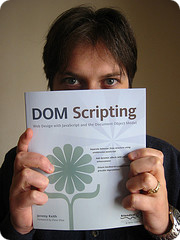I am still working to clean up code of OMap 1.1. However I think it is time to see the horizon OMap 1.x can reach and what are there beyond it.
If OMap 1.x can be defined as challenges about what DOM scripting using Google Maps API can help bloggers, I can also say that it has its own limitations by what only JavaScipt programs on web browser can do. It is because OMap 1.x can work only with data in the web page where OMap is called.
If OMap is going to work with external information outside the web page, collaboration with server side programs will be required for the following processes:
- Collecting information in the Web, such as photos on Flickr having place information and taken in the map area OMap shows
- Storing information in files or database, in order to enable asynchronous collecting process by server side programs
- Publishing information, which OMap subscribes and receives to put markers on the map
The biggest challenge among above items is 3 if OMap makes use of
Comet's style of communication with server side programs. Besides if Comet can be exploited by OMap, it can provide a sort of chat on the map, though it might be beyond OMap just as a set of helper functions to blogging. But it must be fun.
Lastly I summarize what I mus accomplish by OMap 1.x, because OMap 1.x should be the base for any enhancements by OMap 2.0. The following items will be implemented by OMap 1.x:
- Writing a post from the map
- Using of Geocoding API to locate a place in the map by keywords
- Using of GPlolyline to connect selected markers on the map
- Standardizing info windows on the marker with multiple tabs
- Refining code base for OMap 2.x extensions
It is also important before ending this post to summarize what
OMap 1.1 has accomplished so far.
- Basic use of Google Maps API services, such as showing maps and putting markers and info windows there
- Map based navigation to blog posts as the map on the top of page, an example of this can be seen at OMap: Walking.
- Separation of layout information from JavaScript code to an external CSS file


No comments:
Post a Comment